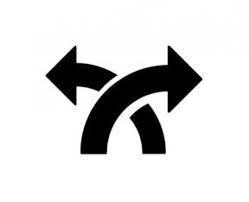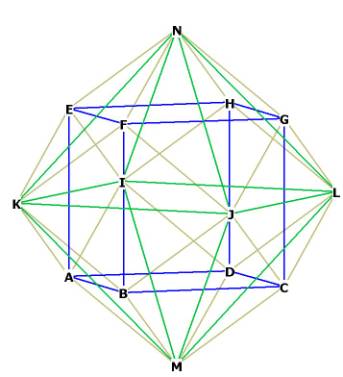|
(2017
midterm assignment) Model Student Midterm answers 2017 (Index) Essay 1: Compare, contrast, and evaluate Narratives of the Future |
 |
Katie
Morin
10/10/2017
Destiny Defined: Analyzing Narratives of the Future
As someone who had yet to study the genre of futuristic literature, I was
surprised to discover just how complex the genre truly is. Works of the future
are multifaceted and can generally be grouped under one of three storylines:
creation/apocalypse, evolution, and alternative futures. While these are just
the three primary narratives of futuristic literature, these groups are not
entirely exclusive of one another, and it is not uncommon to notice elements
from one storyline present in another. Over the course of the semester, I have
gained a deeper understanding of each of the three storylines, and a newfound
appreciation for futuristic literature as a whole.
The creation/apocalypse narrative has a linear timeline, with a clear
beginning and end. This is largely attributed to Judeo-Christian ideology, which
brings to us the concepts of Alpha/Omega, beginning/end, and Genesis/Revelation.
According to our course’s website, as a storyline, this linear “model conforms
to Aristotle (Poetics VII) that a plot or narrative must have ‘a beginning, a
middle, and an end.’” It is a straightforward timeline which most people have
some level of familiarity with. However, in some instances, this linear model
can become a bit more complex as it can appear somewhat cyclical—for example,
certain aspects from “the beginning” or Creation reappear during “the end” or
the Apocalypse. For instance, union with God is first seen in Eden’s utopia, and
also later in The Book of Revelation, where we read of Heaven’s own reunion with
God. As discussed in class, another example of this cyclical pattern is
Genesis’s Tree of Life also making a return appearance in the book of
Revelation.
When
considering the Bible, Genesis marks the beginning of Creation, while Revelation
both begins the formation of a dystopia (the Apocalypse), and later in chapters
21-22, the beginning of a utopia: Heaven. A utopia is a society where everything
appears to be running smoothly, and all of its members are seemingly
happy/content. In contrast, as defined by our course’s website, a dystopia is a
“society opposite from a utopia, a utopia
gone dysfunctional, or the world just before an apocalypse or ‘left behind’
after one.” In works of the future, dystopias appear to be far more common than
utopias. A prime example of a dystopian/apocalyptic society can be seen in
Octavia Butler’s Parable of the Sower.
In it, the story’s protagonist, Lauren, finds the world around her
self-destructing—the government is corrupt, water is scarce, fire is rampant,
and violence has her world in ruins. It is the start of the apocalypse, the
beginning of the end, whether Lauren is ready for it or not.
In contrast, the second type of futuristic storyline, the evolutionary
narrative, appears to emphasize free will and adaptability. Only the strong
survive, and evolution is necessary in order to stay alive. Although
Parable of the Sower falls under the
creation/apocalypse narrative, Lauren herself exhibits characteristics seen in
the evolutionary narrative. The world as she knows it is ending, but she takes
it upon herself to evolve/adapt to her new normal. She begins to form Earthseed,
her own religion, and Lauren repeats over and over that “God is Change”—she is
ultimately able to save herself by evolving as an individual. Lauren also serves
as an example of our course’s definition of evolution (evolution = change +
continuity), as indicated by Karin Cooper’s midterm, “The Alternative Evolution
of the Apocalypse” (2015). Cooper writes that while the group Lauren creates is
new, Earthseed still resembles the community in which she was raised. Cooper
argues that Lauren’s formation of a new group still falls “within the bounds of
the evolution narrative because while the community she starts has similarities
to the one she came from, it does have changes that make it more able to survive
in the new environment in which it was founded.” While she still maintains
certain aspects of the life she once led, Lauren must adapt and evolve in order
to make it in her post-apocalyptic world.
“Stone Lives” by Paul Di Filippo exemplifies the evolutionary narrative in a
more obvious way, where the protagonist, Stone, is blinded, then given a new set
of bionic eyes, and introduced to a new world of technology. In order to survive
the post-apocalypse, he must learn to adapt/evolve to his new surroundings, much
like Lauren does in Parable.
Similarly, “Bears Discover Fire” by Terry Bisson is also classified as an
evolutionary narrative, although far more primitive and less technological than
“Stone Lives.” In it, bears have evolved
to the point that they are fully capable of starting fires, and can also
interact with humans without behaving aggressively, possibly another example of
their growth as a species. However, apart from these more obvious signs of
evolution, the short story also features less obvious signs of evolution, such
as the protagonist’s hesitancy to upgrade to radial tires, which is reiterated
time and time again, presumably to emphasize the changing times.
Finally, the last narrative, alternative future fiction, is likely the strangest
of the three subgenres. Concerning alternative futures, our course website reads
that “according to postmodern quantum physics or relativity, time travel and
multiple strands of time are theoretically real or at least probable.” It goes
on to state that because of this strangeness and all that comes with it
(“multiple universes, parallel worlds, time portals, worm-holes”), alternative
future narratives might appear to be “far-fetched” to some, but this is not
necessarily a bad thing, as some may find the uniqueness of the genre to be
appealing. H.G. Wells’s The Time Machine
is an example of this genre, as it explores time travelling. This narrative is
especially interesting, though, because it is also an evolutionary narrative
following a linear timeline which allows the Traveller to witness the growth and
decline of the world as he transports to and from different time periods both
before and after the one in which he resides. And although it does seem
unrealistic at times, there is some level of relatability as the Time Traveller
has almost humanlike interactions with the majority of the creatures he
encounters (the Eloi and the Morlocks), and does not divulge too much
information concerning strange organisms he discovers (such as the giant crabs
or octopus-like creature). This stands in agreement with what we have discussed
in class, where in order for a work of science fiction to be not only
interesting, but convincing, there can only be one “unbelievable” or “magical”
component (in this case the time machine itself), and all of the rest should be
relatively believable, hence why the Traveller could not possibly interact with
the foreign creatures any more than what has been described, simply because it
would have become far too far-fetched and unbelievable.
Believability is an issue which arises in each of the narratives that we have
covered, save for one. “Better be Ready ‘bout Half Past Eight” by Allison Baker
is one of the pieces that I found to be most interesting simply because it is
not one that I would have initially associated with any of the three genres, let
alone alternative future. In it, the story’s protagonist, Byron, struggles with
the realization that his lifelong friend, Zach, is transitioning to “Zoe,” and
as the story progresses Byron begins to internalize her plight, and experiments
with makeup, transforming himself into a woman for no particular reason. At
certain points, he also has conversations with his deceased mother, and as he
struggles with his own identity, seems to take on his mother’s as well. Although
this narrative may not appear to be as much of an alternative future narrative
as The Time Machine, it still meets
the criteria of the genre as the characters struggle with which paths they
should ultimately take, and subsequently dictate their own futures.
 |
 |
 |
